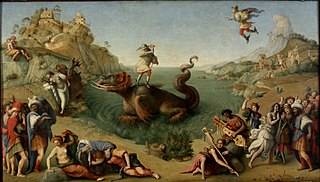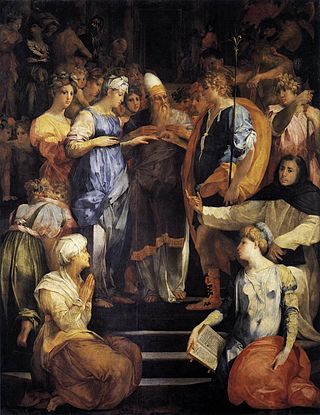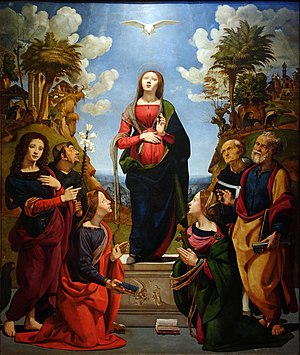
Paolo Uccello, born Paolo di Dono, was an Italian painter and mathematician who was notable for his pioneering work on visual perspective in art. In his book Lives of the Most Excellent Painters, Sculptors, and Architects, Giorgio Vasari wrote that Uccello was obsessed by his interest in perspective and would stay up all night in his study trying to grasp the exact vanishing point. While his contemporaries used perspective to narrate different or succeeding stories, Uccello used perspective to create a feeling of depth in his paintings. His best known works are the three paintings representing the battle of San Romano, which were wrongly entitled the Battle of Sant'Egidio of 1416 for a long period of time.

Filippino Lippi was an Italian painter working in Florence, Italy during the later years of the Early Renaissance and first few years of the High Renaissance.

Piero della Francesca was an Italian painter of the Early Renaissance. To contemporaries he was also known as a mathematician and geometer. Nowadays Piero della Francesca is chiefly appreciated for his art. His painting is characterized by its serene humanism, its use of geometric forms and perspective. His most famous work is the cycle of frescoes The History of the True Cross in the church of San Francesco in the Tuscan town of Arezzo.

Lorenzo Monaco was an Italian painter of the late Gothic to early Renaissance age. He was born Piero di Giovanni in Siena, Italy. Little is known about his youth, apart from the fact that he was apprenticed in Florence. He was influenced by Giotto and that artist's followers Spinello Aretino and Agnolo Gaddi.

Piero di Cosimo, also known as Piero di Lorenzo, was an Italian painter of the Renaissance.

Agnolo Gaddi (c.1350–1396) was an Italian painter. He was born and died in Florence, and was the son of the painter Taddeo Gaddi, who was himself the major pupil of the Florentine master Giotto.

The Coronation of the Virgin is a painting of the Coronation of the Virgin by the Italian Renaissance master Filippo Lippi, in the Uffizi, Florence.

Portrait of a Man with a Medal of Cosimo the Elder, also known as Portrait of a Youth with a Medal, is a tempera painting by Italian Renaissance painter Sandro Botticelli. The painting features a young man displaying in triangled hands a medal stamped with the likeness of Cosimo de' Medici. The identity of the young man has been a long-enduring mystery. Completed in approximately 1475, it is on display in the Uffizi Gallery of Florence.

Perseus Freeing Andromeda or Liberation of Andromeda is a painting created by Piero di Cosimo, during the Italian Renaissance. The painting was praised by critics and art historians for its aesthetic, cosmological and political implications. The painting is a recreation of the myth of Perseus, the demi-god, who slays the sea monster and saves the beautiful Andromeda. The painting is based on a story created by the ancient Roman writer Ovid, in the Metamorphoses. The themes of the painting include platonic love, ideal beauty, marriage, and natural beauty. The painting includes portraits of the Medici family and many of Florentine's elite upper ruling class as characters in the story of Perseus Freeing Andromeda. The painting also represents a paragone between painting and sculpture. The painting resides in the Uffizi in Florence.

The Santa Trinita Maestà is a panel painting by the Italian medieval artist Cimabue, dating to c. 1290-1300. Originally painted for the church of Santa Trinita, Florence, where it remained until 1471, it is now housed in the Uffizi Gallery of Florence, Italy. It represents the Madonna enthroned with the Baby Jesus and surrounded by eight angels and, below, four half portraits of prophets.

The Annunciation with St. Margaret and St. Ansanus is a painting by the Italian Gothic artists Simone Martini and Lippo Memmi, now housed in the Uffizi Gallery in Florence, Italy. It is a wooden triptych painted in tempera and gold, with a central panel having double size. Considered Martini's masterwork and one of the most outstanding works of Gothic painting, the work was originally painted for a side altar in the Siena Cathedral.

The Lamentation of Christ is an oil-on-panel painting of the common subject of the Lamentation of Christ by the Netherlandish artist Rogier van der Weyden, dating from around 1460–1463 and now in the Uffizi Gallery, Florence, Italy.

Faith is a 1470 oil on panel painting by Piero del Pollaiuolo, now in the Uffizi in Florence.

Charity is a 1469 oil on panel painting by Piero del Pollaiuolo, now in the Uffizi in Florence.

Portrait of a Woman is a c.1475 tempera and oil on panel painting by Antonio or Piero del Pollaiuolo. It has been in the Uffizi in Florence since 1861. Since 1861 it has been misattributed to Piero della Francesca, a young Leonardo da Vinci and Cosimo Rosselli.

Noli me tangere is an oil-on-canvas painting by Andrea del Sarto, executed c. 1510, depicting Jesus and Mary Magdalene soon after the resurrection. It was the first painting he produced for the Augustinian San Gallo church in Florence, as recorded by Anonimo Magliabechiano and in Vasari's Lives of the Artists, and he later produced the San Gallo Annunciation and The Disputation on the Trinity for the same church. It is now in the Uffizi.

Marriage of the Virgin or the Ginori Altarpiece is a 1523 oil on panel painting by Rosso Fiorentino, signed and dated by the artist. It was commissioned by Carlo Ginori for the chapel dedicated to the Virgin Mary and saint Joseph - previously owned by the Masi family that chapel had been acquired by the Ginori family in 1520. It still hangs in the Basilica, whilst a drawn copy attributed to Antonio Circignani is now in the Louvre (n.1592).

Supper at Emmaus is a 1525 oil on canvas painting by Pontormo and now in the Uffizi in Florence. It is one of the smallest works signed and dated by the artist, in this case on the abandoned scroll in the foreground.

The Museums of Florence form a key element of the cultural and artistic character of the city. Of the 15 most visited Italian art museums and galleries, five are in Florence. The number and proximity of the works of art in the museums of Florence can trigger the Stendhal syndrome on visitors who try to see them all, as evidenced by hospital records of hundreds of visitors each year affected by the syndrome. The art in Florence was one of the elements that contributed to the central part of the city being named a UNESCO World Heritage Site.

The Martyrdom of Saint Florian is an oil-on-panel painting executed c.1518–1520 by the German artist Albrecht Altdorfer, signed with his "A in A" monogram on a post of the bridge on the right. It and the artist's Saint Florian Taking Leave of the Monastery were in the Spannocchi collection of the Pinacoteca nazionale di Siena until 1914, when they were both transferred to their present home in the Uffizi in Florence to strengthen the latter's holdings on the Northern Renaissance.



















